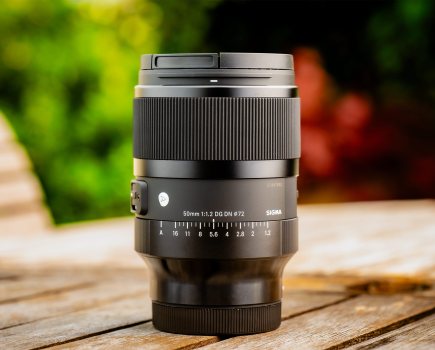What is the Sigma 135mm f/1.8 DG HSM Art?
Since the inception of its premium Art range of lenses towards the end of 2012, Sigma has gone from strength to strength. The 35mm f/1.4 DG HSM Art lens that kicked the whole series off has since been joined by four more focal lengths – 20mm, 24mm, 50mm and 85mm – to fill out an impressive set of f/1.4 primes.
For its next move, the firm is going wider and longer with slightly slower f/1.8 designs, and here we’re looking at the Sigma 135mm f/1.8 DG HSM Art – a beast of a lens with a hefty £1399 price tag.
Perhaps surprisingly, this is the first new autofocus 135mm prime lens for DSLR cameras that we’ve seen for quite some time. While Canon, Nikon and Sony’s offerings are all superb, they’re looking a bit long in the tooth, and the brand-new Milvus 135mm f/2 announced by Zeiss at Photokina last year is manual focus only.
So Sigma has the opportunity to show us just how good a fast autofocus 135mm prime can be with an up-to-the-minute, no-compromise optical design. And boy does it deliver.
Sigma 135mm f/1.8 DG HSM Art – Features
Sigma is making some very bold claims for this new optic, saying that not only is it suitably sharp for use with 50-megapixel sensors, it also minimises axial chromatic aberration. To this end the 13-element, 10-group design includes two super-low dispersion (SLD) glass elements and two ‘F’ low dispersion (FLD) glass elements. The aim is to give super-sharp, clean images, even at f/1.8.

Autofocus is driven by an ultrasonic-type hypersonic motor, with full-time manual focus override also available. A floating focus mechanism is employed to maintain high image quality across the full focus distance range, from infinity to a minimum of 87.5cm. At this point the lens gives a maximum magnification of 0.2x, which equates to a subject area of 12 x 18cm with full-frame cameras.
Sigma has installed a diaphragm mechanism with nine rounded blades that keeps the aperture near-circular down to the smallest setting on offer, which is f/16. Nikon users will benefit from a built-in electromagnetic diaphragm of the type Canon users have enjoyed for years, which Sigma says should give more stable exposure during continuous shooting.

The lens is available in Canon, Nikon and Sigma mounts, but it can also be used on Sony E-mount cameras via the £200 Sigma MC-11 mount converter, with all functions seamlessly maintained – including autofocus and electronic aperture setting.
Sigma 135mm f/1.8 DG HSM Art – Build and Handling
The first thing you’ll notice on unboxing the 135mm is its size; at 91.4mm in diameter and 114.9mm in length, it’s a hefty piece of kit that weighs 1130g. As most of the glass is concentrated towards the front of the lens, it actually feels heavier in-hand than you might expect.
It’s definitely best suited for use on larger cameras such as the Canon EOS 5D series; on more modestly sized bodies such as the Sony Alpha 7 II, for example, it becomes very front-heavy. I certainly began to notice its weight after carrying it around for a few hours – it isn’t something you’d want to lug around on the off-chance of finding a suitable subject.

Build quality is exactly as we’ve come to expect from Sigma’s premium line, which means it’s very good indeed. Ahead of a metal section immediately adjacent to the camera body, the barrel is predominantly made of high-quality plastics. The large manual focus ring rotates extremely smoothly without any hint of backlash, with a small window on the top of the barrel indicating the current focus distance.
A rubber seal to stop dust or water getting into the camera encircles the lens mount, while the front and rear glass surfaces are treated to a water- and oil-repellent coating.

At the front of the lens you’ll find a non-rotating thread for attaching 82mm filters. It’s surrounded by a bayonet mount for the deep cylindrical hood, which can be reversed over the barrel when not in use.
On the side there’s a pair of switches, one to change between auto and manual focus, and another that can be used to limit the focus distance range to 1.5m to infinity, or 0.875m to 1.5m. This can be handy for reducing hunting in some situations.

As is usual from Sigma, the lens is rounded off by a few neat design touches: a white inlay in the focus mode switch gives a quick visual confirmation of when it’s set to autofocus, while a ridged grip around the non-rotating section of the barrel affords a secure hold.
Continues below…
[collection name=”small”]
Sigma 135mm f/1.8 DG HSM Art – Autofocus
Sigma has employed a focusing mechanism that moves the smaller elements towards the rear of the lens, and this gives impressively fast and decisive autofocus on the Canon EOS 5D Mark IV I used for testing.

For close focus distances, of up to 4 or 5 metres perhaps, I found the AF was pretty accurate; at longer distances it became increasingly less reliable, however. This kind of behaviour is pretty common with SLRs and becomes ever more visible as sensor resolutions increase. As a result, you’ll almost certainly need to configure autofocus micro-adjustment to get consistently pin-sharp autofocus.
For this purpose the 135mm is compatible with Sigma’s USB dock, which also allows the lens’ firmware to be updated in future if this turns out to be necessary. Meanwhile, to achieve accurate manual focus on a DSLR you’ll need to use magnified live view – forget about trying to use the viewfinder.

I also tested the lens on a Sony Alpha 7 II using the MC-11 converter and discovered that while the autofocus slows down noticeably, it’s still quite tolerable. But the huge advantage is that the camera’s on-sensor hybrid AF system gives consistently accurate results, no matter what the focus distance and wherever in the frame you place the focus point.
Unlike with the optical finder of a DSLR, you’ll also achieve an accurate representation of focus and depth of field, no matter what aperture you’re using – large or small. Switch to manual focus mode and you’ll find that turning the focus ring will automatically engage the magnified MF Assist view.
Sigma 135mm f/1.8 DG HSM Art – Image Quality
So now for the burning question: exactly what does £1399 buy you in terms of optical quality? If you’ve read any of our recent reviews of Sigma lenses, the answer won’t surprise you one iota. You get an absolutely stunning lens with superb sharpness and very few optical aberrations or flaws to speak of.
 Sony Alpha 7 II with MC-11, 1/1250sec at f/1.8, ISO 800
Sony Alpha 7 II with MC-11, 1/1250sec at f/1.8, ISO 800
Indeed, when I reviewed the Zeiss Batis 135mm f/2.8 recently, I remarked that few lenses would be able to match it. But the Sigma comes astonishingly close, despite its stop-and-a-half faster aperture.
 Canon EOS 5D Mark IV, 1/250sec at f/1.8, ISO 100
Canon EOS 5D Mark IV, 1/250sec at f/1.8, ISO 100
It resolves an impressive amount of detail wide open, while blurring away beautifully out-of-focus elements both in front of, and behind the plane of focus. Chromatic aberration is exceptionally low, if not entirely absent; distortion is negligible, and vignetting is kept to very acceptable levels. If you can’t get lovely pictures with this lens, it probably isn’t Sigma’s fault.
 Canon EOS 5DS R, 1/2500sec at f/1.8, ISO 2000
Canon EOS 5DS R, 1/2500sec at f/1.8, ISO 2000
However, this is a lens that will tax your photographic technique to the limit. Depth of field at f/1.8 is vanishingly slim, so the slightest movement of either the photographer or subject after focusing will be plainly visibly when viewing your images on-screen.
 Canon EOS 5DS R, 1/200sec at f/2.5, ISO 200
Canon EOS 5DS R, 1/200sec at f/2.5, ISO 200
What’s more, I found that with its concentrated weight, the Sigma 135mm is surprisingly difficult to keep steady hand-held; in general, I needed shutter speeds around 1/500sec to be reliably free from blur, and only a stop or so slower when using the Sony Alpha 7 II with its in-body stabilisation. This contrasts with the Zeiss Batis 135mm f/2.8, which consistently gave me sharp hand-held shots at much slower shutter speeds due to its lighter weight and optical stabilisation.
Resolution
Tested on the 42.4-megapixel Sony Alpha 7R II, the Sigma 135mm f/1.8 achieves astonishing results in our Applied Imaging MTF tests. In the centre of the frame it’s sharper wide open than most lenses achieve at their best apertures. Not surprisingly, the corners aren’t quite as stunning at f/1.8, but stop down to f/5.6 and they catch up with the centre. This is one of the most impressive sets of MTF measurements we’ve seen to date.

Sigma 135mm f/1.8 DG HSM Art – Shading
The 135mm gives impressively low vignetting for a fast prime, aided no doubt by its large front elements. Even at f/1.8 we see little over a stop of fall-off in illumination at the frame corners, with a gradual profile that isn’t unattractive. Stop down to f/2.8 and vignetting is practically eliminated.
 Sigma 135mm f/1.8 DG HSM Art corner shading at f/1.8
Sigma 135mm f/1.8 DG HSM Art corner shading at f/1.8 Sigma 135mm f/1.8 DG HSM Art corner shading at f/2.8
Sigma 135mm f/1.8 DG HSM Art corner shading at f/2.8
Sigma 135mm f/1.8 DG HSM Art – Curvilinear Distortion
Distortion is exceptionally low. In our chart tests we can measure just a hint of pincushion-type curvature of lines towards the edges of the frame. Examination of real-world images shows this to be of no concern whatsoever, but if you’re super-picky it can easily be corrected in software. Sigma 135mm f/1.8 DG HSM Art = 0.5% TV SMIA
Sigma 135mm f/1.8 DG HSM Art = 0.5% TV SMIA
Should I buy the Sigma 135mm f/1.8 DG HSM Art?
With its hefty size and even heftier price tag, the Sigma 135mm f/1.8 DG HSM Art is a specialist optic that’s mainly aimed at portrait and wedding photographers looking for something extra to make their images stand out from the crowd. With its wonderful sharpness and dreamy background blur, it provides a look that few other lenses can match.

But stunning as it is, the problem facing Sigma is that the closest rivals from Sony, Canon and Nikon are all rather cheaper, while still being some of the most highly regarded lenses in their respective ranges. The Canon and Nikon f/2 optics are a fair bit slimmer and lighter too, which makes them more practical to carry around during a prolonged shoot.
Despite this, Sigma has to be applauded for bringing such a spectacularly fine lens to market.
This review was originally posted on Trusted Reviews







